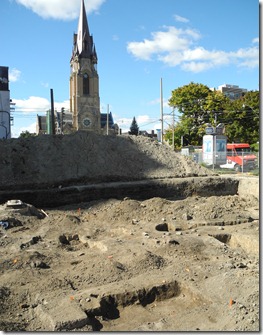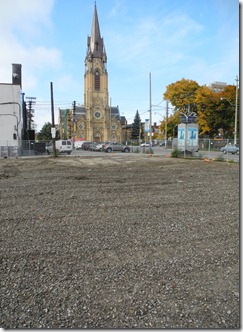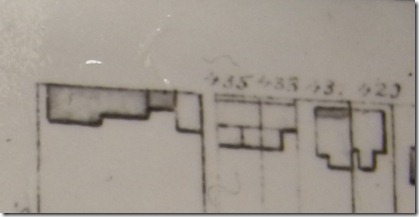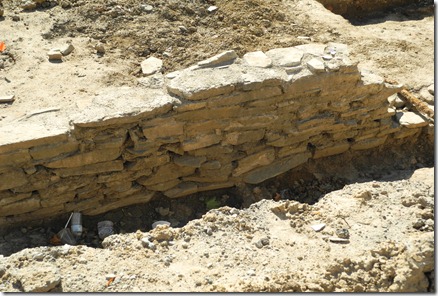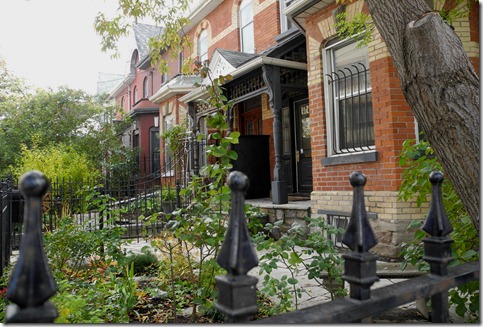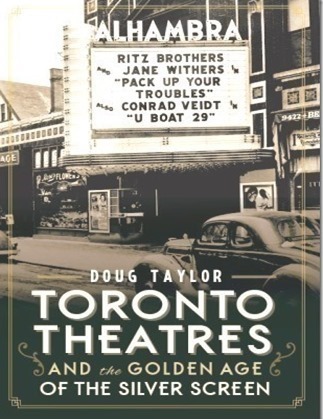The site of the archaeological dig, St. Mary’s Church in the background. The photo on the left was taken 12 October, and the one on the right on 19 October 2012.
On 12 October 2012, a post appeared on this blog about the archaeological dig that was in progress in a parking lot on Adelaide Street, close to the corner of Bathurst Street. The parking lot is part of a parcel of land that has been assembled to construct a condo on Bathurst Street, which includes the former location of Waddington’s, the auction company. The site is near the historic church of St. Mary’s Roman Catholic, which has recently had the scaffolding removed from its facade following a lengthy period of restoration. The previous post was published before I had researched the location of the dig. I did this as I knew these sites do not remain uncovered for long.
In the historic area of the city, before a site disappears beneath a new building, the land is examined in an attempt to recover and document the city’s past before it is irretrievably lost. Sometimes, a few nineteenth-century objects are found, and in rare cases, traces of the history of Canada’s native peoples. The site at Bathurst and Adelaide Streets has now been covered over, ready to be excavated for the condo.
1884 map of the houses on the land on the southeast corner of Adelaide and Bathurst Streets.
Since my original post, I have researched the site in the Toronto Reference Library. The 1884 map, shown above, is from the Goad’s Atlas. It depicts the houses that occupied the land at the corner of Bathurst and Adelaide Street. At the top of the map is Adelaide Street, and Bathurst Street appears on the left of the map. The Toronto Directories reveal that there were no houses on the site in 1873, as the postal numbers stopped at number 423. In 1874, houses appear on the site where the archaeological dig occurred, but there are two sets of houses. Which ones were located on the dig site?
The dig revealed that the houses on the site were set back from the street, so the homes in question were probably numbers 429 and 431. They are the pair of houses on the right-hand side of the map. They were likely similar in design to the houses further east along the street, which date from the same period. If this proves to be true, then in 1874, number 429 was the dwelling of Timothy Sullivan, who was employed as a mason. The house at number 431 was being lived in by the family of James Hannon, a labourer.
Foundation walls of number 429 Adelaide Street, set back from the front of the lot line.
The houses at 429 and 431 Adelaide Streets were likely similar to these houses that are a short distance to the east, and were built in the same decade. The houses in the pictures above have been restored and are in excellent condition. The condition of the houses on the dig site is unknown.
To view the original post about the archaeological site at Bathurst and Adelaide Streets:
To view the Home Page for this blog: https://tayloronhistory.com/
Links to other posts about the history of Toronto and its buildings:
https://tayloronhistory.com/2013/10/08/links-to-historic-architecture-of-torontotayloronhistory-com/
Links to posts about Toronto’s movie houses—past and present.
https://tayloronhistory.com/2013/10/09/links-to-toronto-old-movie-housestayloronhistory-com/
Recent publication entitled “Toronto’s Theatres and the Golden Age of the Silver Screen,” by the author of this blog. The publication explores 50 of Toronto’s old theatres and contains over 80 archival photographs of the facades, marquees and interiors of the theatres. It also relates anecdotes and stories from those who experienced these grand old movie houses.
To place an order for this book:
Theatres Included in the Book
Chapter One – The Early Years—Nickelodeons and the First Theatres in Toronto
Theatorium (Red Mill) Theatre—Toronto’s First Movie Experience and First Permanent Movie Theatre, Auditorium (Avenue, PIckford), Colonial Theatre (the Bay), thePhotodome, Revue Theatre, Picture Palace (Royal George), Big Nickel (National, Rio), Madison Theatre (Midtown, Capri, Eden, Bloor Cinema, Bloor Street Hot Docs), Theatre Without a Name (Pastime, Prince Edward, Fox)
Chapter Two – The Great Movie Palaces – The End of the Nickelodeons
Loew’s Yonge Street (Elgin/Winter Garden), Shea’s Hippodrome, The Allen (Tivoli), Pantages (Imperial, Imperial Six, Ed Mirvish), Loew’s Uptown
Chapter Three – Smaller Theatres in the pre-1920s and 1920s
Oakwood, Broadway, Carlton on Parliament Street, Victory on Yonge Street (Embassy, Astor, Showcase, Federal, New Yorker, Panasonic), Allan’s Danforth (Century, Titania, Music Hall), Parkdale, Alhambra (Baronet, Eve), St. Clair, Standard (Strand, Victory, Golden Harvest), Palace, Bedford (Park), Hudson (Mount Pleasant), Belsize (Crest, Regent), Runnymede
Chapter Four – Theatres During the 1930s, the Great Depression
Grant ,Hollywood, Oriole (Cinema, International Cinema), Eglinton, Casino, Radio City, Paramount, Scarboro, Paradise (Eve’s Paradise), State (Bloordale), Colony, Bellevue (Lux, Elektra, Lido), Kingsway, Pylon (Royal, Golden Princess), Metro
Chapter Five – Theatres in the 1940s – The Second World War and the Post-War Years
University, Odeon Fairlawn, Vaughan, Odeon Danforth, Glendale, Odeon Hyland, Nortown, Willow, Downtown, Odeon Carlton, Donlands, Biltmore, Odeon Humber, Town Cinema
Chapter Six – The 1950s Theatres
Savoy (Coronet), Westwood
Chapter Seven – Cineplex and Multi-screen Complexes
Cineplex Eaton Centre, Cineplex Odeon Varsity, Scotiabank Cineplex, Dundas Square Cineplex, The Bell Lightbox (TIFF)
